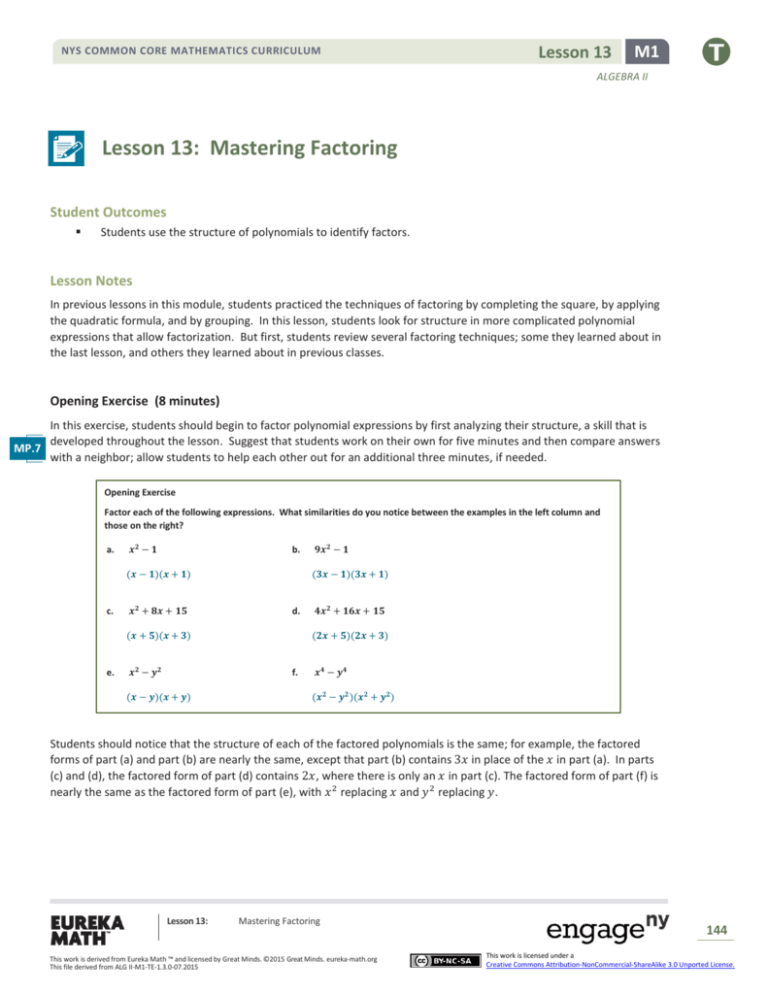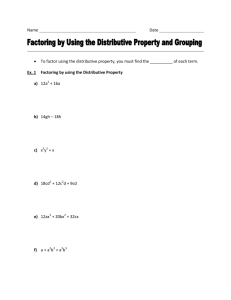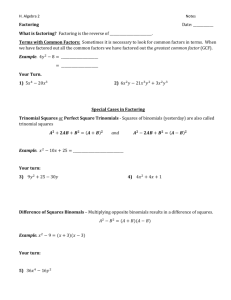Lesson 13: Mastering Factoring
advertisement

NYS COMMON CORE MATHEMATICS CURRICULUM Lesson 13 M1 ALGEBRA II Lesson 13: Mastering Factoring Student Outcomes Students use the structure of polynomials to identify factors. Lesson Notes In previous lessons in this module, students practiced the techniques of factoring by completing the square, by applying the quadratic formula, and by grouping. In this lesson, students look for structure in more complicated polynomial expressions that allow factorization. But first, students review several factoring techniques; some they learned about in the last lesson, and others they learned about in previous classes. Opening Exercise (8 minutes) In this exercise, students should begin to factor polynomial expressions by first analyzing their structure, a skill that is developed throughout the lesson. Suggest that students work on their own for five minutes and then compare answers MP.7 with a neighbor; allow students to help each other out for an additional three minutes, if needed. Opening Exercise Factor each of the following expressions. What similarities do you notice between the examples in the left column and those on the right? a. 𝒙𝟐 − 𝟏 b. (𝒙 − 𝟏)(𝒙 + 𝟏) c. 𝒙𝟐 + 𝟖𝒙 + 𝟏𝟓 (𝟑𝒙 − 𝟏)(𝟑𝒙 + 𝟏) d. (𝒙 + 𝟓)(𝒙 + 𝟑) e. 𝒙𝟐 − 𝒚𝟐 𝟒𝒙𝟐 + 𝟏𝟔𝒙 + 𝟏𝟓 (𝟐𝒙 + 𝟓)(𝟐𝒙 + 𝟑) f. (𝒙 − 𝒚)(𝒙 + 𝒚) 𝟗𝒙𝟐 − 𝟏 𝒙𝟒 − 𝒚𝟒 (𝒙𝟐 − 𝒚𝟐 )(𝒙𝟐 + 𝒚𝟐 ) Students should notice that the structure of each of the factored polynomials is the same; for example, the factored forms of part (a) and part (b) are nearly the same, except that part (b) contains 3𝑥 in place of the 𝑥 in part (a). In parts (c) and (d), the factored form of part (d) contains 2𝑥, where there is only an 𝑥 in part (c). The factored form of part (f) is nearly the same as the factored form of part (e), with 𝑥 2 replacing 𝑥 and 𝑦 2 replacing 𝑦. Lesson 13: Mastering Factoring This work is derived from Eureka Math ™ and licensed by Great Minds. ©2015 Great Minds. eureka-math.org This file derived from ALG II-M1-TE-1.3.0-07.2015 144 This work is licensed under a Creative Commons Attribution-NonCommercial-ShareAlike 3.0 Unported License. Lesson 13 NYS COMMON CORE MATHEMATICS CURRICULUM M1 ALGEBRA II Discussion (2 minutes) Scaffolding: The difference of two squares formula, 2 2 𝑎 − 𝑏 = (𝑎 + 𝑏)(𝑎 − 𝑏), can be used to factor an expression even when the two squares are not obvious. Consider the following examples. If students are unfamiliar with the difference of squares formula, work through a table of numeric examples, and ask them to look for patterns. 𝑎 3 4 5 6 Example 1 (3 minutes) Example 1 Write 𝟗 − 𝟏𝟔𝒙𝟒 as the product of two factors. 𝟗 − 𝟏𝟔𝒙𝟒 = (𝟑)𝟐 − (𝟒𝒙𝟐 )𝟐 𝑏 1 1 2 4 𝑎+𝑏 4 5 7 10 𝑎−𝑏 2 3 3 2 𝑎2 − 𝑏 2 8 15 21 20 Students may benefit from teacher modeling. = (𝟑 − 𝟒𝒙𝟐 )(𝟑 + 𝟒𝒙𝟐 ) Example 2 (3 minutes) Example 2 Factor 𝟒𝒙𝟐 𝒚𝟒 − 𝟐𝟓𝒙𝟒 𝒛𝟔. 𝟒𝒙𝟐 𝒚𝟒 − 𝟐𝟓𝒙𝟒 𝒛𝟔 = (𝟐𝒙𝒚𝟐 )𝟐 − (𝟓𝒙𝟐 𝒛𝟑 )𝟐 = (𝟐𝒙𝒚𝟐 + 𝟓𝒙𝟐 𝒛𝟑 )(𝟐𝒙𝒚𝟐 − 𝟓𝒙𝟐 𝒛𝟑 ) = [𝒙(𝟐𝒚𝟐 + 𝟓𝒙𝒛𝟑 )][𝒙(𝟐𝒚𝟐 − 𝟓𝒙𝒛𝟑 )] = 𝒙𝟐 (𝟐𝒚𝟐 + 𝟓𝒙𝒛𝟑 )(𝟐𝒚𝟐 − 𝟓𝒙𝒛𝟑 ) Have students discuss with each other the structure of each polynomial expression in the previous two examples and how it helps to factor the expressions. There are two terms that are subtracted, and each term can be written as the square of an expression. Example 3 (3 minutes) Consider the quadratic polynomial expression 9𝑥 2 + 12𝑥 − 5. We can factor this expression by considering 3𝑥 as a single quantity as follows: 9𝑥 2 + 12𝑥 − 5 = (3𝑥)2 + 4(3𝑥) − 5. Ask students to suggest the next step in factoring this expression. Now, if we rename 𝑢 = 3𝑥, we have a quadratic expression of the form 𝑢2 + 4𝑢 − 5, which we can factor 𝑢2 + 4𝑢 − 5 = (𝑢 − 1)(𝑢 + 5). Replacing 𝑢 by 3𝑥, we have the following form of our original expression: 9𝑥 2 + 12𝑥 − 5 = (3𝑥 − 1)(3𝑥 − 5). Lesson 13: Mastering Factoring This work is derived from Eureka Math ™ and licensed by Great Minds. ©2015 Great Minds. eureka-math.org This file derived from ALG II-M1-TE-1.3.0-07.2015 145 This work is licensed under a Creative Commons Attribution-NonCommercial-ShareAlike 3.0 Unported License. Lesson 13 NYS COMMON CORE MATHEMATICS CURRICULUM M1 ALGEBRA II Exercise 1 (4 minutes) Allow students to work in pairs or small groups on the following exercises. Exercise 1 1. Factor the following expressions: a. 𝟒𝒙𝟐 + 𝟒𝒙 − 𝟔𝟑 𝟒𝒙𝟐 + 𝟒𝒙 − 𝟔𝟑 = (𝟐𝒙)𝟐 + 𝟐(𝟐𝒙) − 𝟔𝟑 = (𝟐𝒙 + 𝟗)(𝟐𝒙 − 𝟕) b. 𝟏𝟐𝒚𝟐 − 𝟐𝟒𝒚 − 𝟏𝟓 𝟏𝟐𝒚𝟐 − 𝟐𝟒𝒚 − 𝟏𝟓 = 𝟑(𝟒𝒚𝟐 − 𝟖𝒚 − 𝟓) = 𝟑((𝟐𝒚)𝟐 − 𝟒(𝟐𝒚) − 𝟓) = 𝟑(𝟐𝒚 + 𝟏)(𝟐𝒚 − 𝟓) Example 4 (10 minutes) Use the example of factoring 𝑥 3 − 8 to scaffold the discussion of factoring 𝑥 3 + 8. Students should be pretty familiar by now with factors of 𝑥 3 − 8. Let them try the problem on their own to check their understanding. Suppose we want to factor 𝑥 3 − 8. Do you see anything interesting about this expression? If they do not notice it, guide them toward both terms being perfect cubes. We can rewrite 𝑥 3 − 8 as 𝑥 3 − 23 . Guess a factor. Anticipate that they will suggest 𝑥 − 2 and 𝑥 + 2 as possible factors, or guide them to these suggestions. Ask half of the students to divide 3 𝑥 − 8, but 𝑥 + 2 is not. Lesson 13: 𝑥 3 −8 𝑥−2 and the other half to divide Mastering Factoring This work is derived from Eureka Math ™ and licensed by Great Minds. ©2015 Great Minds. eureka-math.org This file derived from ALG II-M1-TE-1.3.0-07.2015 𝑥 3 −8 𝑥+2 . They should discover that 𝑥 − 2 is a factor of 146 This work is licensed under a Creative Commons Attribution-NonCommercial-ShareAlike 3.0 Unported License. Lesson 13 NYS COMMON CORE MATHEMATICS CURRICULUM M1 ALGEBRA II Use the results of the previous step to factor 𝑥 3 − 8. Repeat the above process for 𝑥 3 − 27. 𝑥 3 − 8 = (𝑥 − 2)(𝑥 2 + 2𝑥 + 4) 𝑥 3 − 27 = (𝑥 − 3)(𝑥 2 + 3𝑥 + 9) Make a conjecture about a rule for factoring 𝑥 3 − 𝑎3 . 𝑥 3 − 𝑎3 = (𝑥 − 𝑎)(𝑥 2 + 𝑎𝑥 + 𝑎2 ) Verify the conjecture: Multiply out (𝑥 − 𝑎)(𝑥 2 + 𝑎𝑥 + 𝑎2 ) to establish the identity for factoring a difference of cubes. While we can factor a difference of squares such as the expression 𝑥 2 − 9, we cannot similarly factor a sum of squares such as 𝑥 2 + 9. Do we run into a similar problem when trying to factor a sum of cubes such as 𝑥 3 + 8? Again, ask students to propose potential factors of 𝑥 3 + 8. Lead students to 𝑥 + 2 if they do not guess it automatically. Work through the polynomial long division for 𝑥 3 +8 x+2 as shown. Conclude that 𝑥 3 + 8 = (𝑥 + 2)(𝑥 2 − 2𝑥 + 4). Make a conjecture about a rule for factoring 𝑥 3 + 𝑎3 . 𝑥 3 + 𝑎3 = (𝑥 + 𝑎)(𝑥 2 − 𝑎𝑥 + 𝑎2 ) Verify the conjecture: Multiply out the expression (𝑥 + 𝑎)(𝑥 2 − 𝑎𝑥 + 𝑎2 ) to establish the identity for factoring a sum of cubes. Exercises 2–4 (5 minutes) Exercises 2–4 Factor each of the following, and show that the factored form is equivalent to the original expression. 2. 𝒂𝟑 + 𝟐𝟕 (𝒂 + 𝟑)(𝒂𝟐 − 𝟑𝒂 + 𝟗) 3. Scaffolding: Ask advanced students to generate their own factoring problems using the structure of 𝑎3 + 𝑏 3 or 𝑎3 − 𝑏 3 . 𝒙𝟑 − 𝟔𝟒 (𝒙 − 𝟒)(𝒙𝟐 + 𝟒𝒙 + 𝟏𝟔) 4. 𝟐𝒙𝟑 + 𝟏𝟐𝟖 𝟐(𝒙𝟑 + 𝟔𝟒) = 𝟐(𝒙 + 𝟒)(𝒙𝟐 − 𝟒𝒙 + 𝟏𝟔) Closing (2 minutes) Ask students to summarize the important parts of the lesson in writing, to a partner, or as a class. Use this as an opportunity to informally assess understanding of the lesson. The following are some important summary elements. Lesson 13: Mastering Factoring This work is derived from Eureka Math ™ and licensed by Great Minds. ©2015 Great Minds. eureka-math.org This file derived from ALG II-M1-TE-1.3.0-07.2015 147 This work is licensed under a Creative Commons Attribution-NonCommercial-ShareAlike 3.0 Unported License. Lesson 13 NYS COMMON CORE MATHEMATICS CURRICULUM M1 ALGEBRA II Lesson Summary In this lesson we learned additional strategies for factoring polynomials. The difference of squares identity 𝒂𝟐 − 𝒃𝟐 = (𝒂 − 𝒃)(𝒂 + 𝒃) can be used to factor more advanced binomials. Trinomials can often be factored by looking for structure and then applying our previous factoring methods. Sums and differences of cubes can be factored by the formulas 𝒙𝟑 + 𝒂𝟑 = (𝒙 + 𝒂)(𝒙𝟐 − 𝒂𝒙 + 𝒂𝟐 ) 𝒙𝟑 − 𝒂𝟑 = (𝒙 − 𝒂)(𝒙𝟐 + 𝒂𝒙 + 𝒂𝟐 ). Exit Ticket (5 minutes) Lesson 13: Mastering Factoring This work is derived from Eureka Math ™ and licensed by Great Minds. ©2015 Great Minds. eureka-math.org This file derived from ALG II-M1-TE-1.3.0-07.2015 148 This work is licensed under a Creative Commons Attribution-NonCommercial-ShareAlike 3.0 Unported License. Lesson 13 NYS COMMON CORE MATHEMATICS CURRICULUM M1 ALGEBRA II Name Date Lesson 13: Mastering Factoring Exit Ticket 1. Factor the following expression, and verify that the factored expression is equivalent to the original: 4𝑥 2 − 9𝑎6 2. Factor the following expression, and verify that the factored expression is equivalent to the original: 16𝑥 2 − 8𝑥 − 3 Lesson 13: Mastering Factoring This work is derived from Eureka Math ™ and licensed by Great Minds. ©2015 Great Minds. eureka-math.org This file derived from ALG II-M1-TE-1.3.0-07.2015 149 This work is licensed under a Creative Commons Attribution-NonCommercial-ShareAlike 3.0 Unported License. Lesson 13 NYS COMMON CORE MATHEMATICS CURRICULUM M1 ALGEBRA II Exit Ticket Sample Solutions 1. Factor the following expression, and verify that the factored expression is equivalent to the original: 𝟒𝒙𝟐 − 𝟗𝒂𝟔 (𝟐𝒙 − 𝟑𝒂𝟑 )(𝟐𝒙 + 𝟑𝒂𝟑 ) = 𝟒𝒙𝟐 + 𝟔𝒂𝟑 𝒙 − 𝟔𝒂𝟑 𝒙 − 𝟗𝒂𝟔 = 𝟒𝒙𝟐 − 𝟗𝒂𝟔 2. Factor the following expression, and verify that the factored expression is equivalent to the original: 𝟏𝟔𝒙𝟐 − 𝟖𝒙 − 𝟑 (𝟒𝒙 − 𝟑)(𝟒𝒙 + 𝟏) = 𝟏𝟔𝒙𝟐 + 𝟒𝒙 − 𝟏𝟐𝒙 − 𝟑 = 𝟏𝟔𝒙𝟐 − 𝟖𝒙 − 𝟑 Problem Set Sample Solutions 1. If possible, factor the following expressions using the techniques discussed in this lesson. a. 𝟐𝟓𝒙𝟐 − 𝟐𝟓𝒙 − 𝟏𝟒 g. (𝟑𝒙 − 𝟓𝒚𝟐 𝒛𝟑 )(𝟑𝒙 + 𝟓𝒚𝟐 𝒛𝟑 ) (𝟓𝒙 − 𝟕)(𝟓𝒙 + 𝟐) b. 𝟗𝒙𝟐 𝒚𝟐 − 𝟏𝟖𝒙𝒚 + 𝟖 h. 𝟒𝟓𝒚𝟐 + 𝟏𝟓𝒚 − 𝟏𝟎 i. 𝟓(𝟑𝒚 + 𝟐)(𝟑𝒚 − 𝟏) d. j. 𝟑 (𝒚 − 𝟑)(𝒚 + 𝟐) e. 𝒙𝟑 − 𝟏𝟐𝟓 k. 𝟐𝒙𝟒 − 𝟏𝟔𝒙 l. 𝟐 𝟐𝒙(𝒙 − 𝟐)(𝒙 + 𝟐𝒙 + 𝟒) 𝟏 + 𝟐𝟕𝒙𝟗 (𝟏 + 𝟑𝒙𝟑 )(𝟏 − 𝟑𝒙𝟑 + 𝟗𝒙𝟔 ) (𝒙 − 𝟓)(𝒙 + 𝟓𝒙 + 𝟐𝟓) Lesson 13: 𝒙𝟒 − 𝟑𝟔 (𝒙 − √𝟔)(𝒙 + √𝟔)(𝒙𝟐 + 𝟔) 𝟐 f. 𝟒𝒙𝟐 + 𝟗 Cannot be factored. 𝒚𝟔 − 𝒚𝟑 − 𝟔 𝟑 𝟑𝟔𝒙𝟔 𝒚𝟒 𝒛𝟐 − 𝟐𝟓𝒙𝟐 𝒛𝟏𝟎 𝒙𝟐 𝒛𝟐 (𝟔𝒙𝟐 𝒚𝟐 − 𝟓𝒛𝟒 )(𝟔𝒙𝟐 𝒚𝟐 + 𝟓𝒛𝟒 ) (𝟑𝒙𝒚 − 𝟒)(𝟑𝒙𝒚 − 𝟐) c. 𝟗𝒙𝟐 − 𝟐𝟓𝒚𝟒 𝒛𝟔 𝒙𝟑 𝒚𝟔 + 𝟖𝒛𝟑 (𝒙𝒚𝟐 + 𝟐𝒛)(𝒙𝟐 𝒚𝟒 − 𝟐𝒙𝒚𝟐 𝒛 + 𝟒𝒛𝟐 ) Mastering Factoring This work is derived from Eureka Math ™ and licensed by Great Minds. ©2015 Great Minds. eureka-math.org This file derived from ALG II-M1-TE-1.3.0-07.2015 150 This work is licensed under a Creative Commons Attribution-NonCommercial-ShareAlike 3.0 Unported License. Lesson 13 NYS COMMON CORE MATHEMATICS CURRICULUM M1 ALGEBRA II 2. Consider the polynomial expression 𝒚𝟒 + 𝟒𝒚𝟐 + 𝟏𝟔. a. Is 𝒚𝟒 + 𝟒𝒚𝟐 + 𝟏𝟔 factorable using the methods we have seen so far? No. This will not factor into the form (𝒚𝟐 + 𝒂)(𝒚𝟐 + 𝒃) using any of our previous methods. b. Factor 𝒚𝟔 − 𝟔𝟒 first as a difference of cubes, and then factor completely: (𝒚𝟐 )𝟑 − 𝟒𝟑 . 𝒚𝟔 − 𝟔𝟒 = (𝒚𝟐 − 𝟒)(𝒚𝟒 + 𝟒𝒚𝟐 + 𝟏𝟔) = (𝒚 − 𝟐)(𝒚 + 𝟐)(𝒚𝟒 + 𝟒𝒚𝟐 + 𝟏𝟔) c. Factor 𝒚𝟔 − 𝟔𝟒 first as a difference of squares, and then factor completely: (𝒚𝟑 )𝟐 − 𝟖𝟐 . 𝒚𝟔 − 𝟔𝟒 = (𝒚𝟑 − 𝟖)(𝒚𝟑 + 𝟖) = (𝒚 − 𝟐)(𝒚𝟐 + 𝟐𝒚 + 𝟒)(𝒚 + 𝟐)(𝒚𝟐 − 𝟐𝒚 + 𝟒) = (𝒚 − 𝟐)(𝒚 + 𝟐)(𝒚𝟐 − 𝟐𝒚 + 𝟒)(𝒚𝟐 + 𝟐𝒚 + 𝟒) d. Explain how your answers to parts (b) and (c) provide a factorization of 𝒚𝟒 + 𝟒𝒚𝟐 + 𝟏𝟔. Since 𝒚𝟔 − 𝟔𝟒 can be factored two different ways, those factorizations are equal. Thus we have (𝒚 − 𝟐)(𝒚 + 𝟐)(𝒚𝟒 + 𝟒𝒚𝟐 + 𝟏𝟔) = (𝒚 − 𝟐)(𝒚 + 𝟐)(𝒚𝟐 − 𝟐𝒚 + 𝟒)(𝒚𝟐 + 𝟐𝒚 + 𝟒). If we specify that 𝒚 ≠ 𝟐 and 𝒚 ≠ −𝟐, we can cancel the common terms from both sides: (𝒚𝟒 + 𝟒𝒚𝟐 + 𝟏𝟔) = (𝒚𝟐 − 𝟐𝒚 + 𝟒)(𝒚𝟐 + 𝟐𝒚 + 𝟒). Multiplying this out, we see that (𝒚𝟐 − 𝟐𝒚 + 𝟒)(𝒚𝟐 + 𝟐𝒚 + 𝟒) = 𝒚𝟒 + 𝟐𝒚𝟑 + 𝟒𝒚𝟐 − 𝟐𝒚𝟑 − 𝟒𝒚𝟐 − 𝟖𝒚 + 𝟒𝒚𝟐 + 𝟖𝒚 + 𝟏𝟔 = 𝒚𝟒 + 𝟒𝒚𝟐 + 𝟏𝟔 for every value of 𝒚. e. If a polynomial can be factored as either a difference of squares or a difference of cubes, which formula should you apply first, and why? Based on this example, a polynomial should first be factored as a difference of squares and then as a difference of cubes. This will produce factors of lower degree. 3. Create expressions that have a structure that allows them to be factored using the specified identity. Be creative, and produce challenging problems! a. Difference of squares 𝒙𝟏𝟒 𝒚𝟒 − 𝟐𝟐𝟓𝒛𝟏𝟎 b. Difference of cubes 𝟐𝟕𝒙𝟗 𝒚𝟔 − 𝟏 c. Sum of cubes 𝒙𝟔 𝒛𝟑 + 𝟔𝟒𝒚𝟏𝟐 Lesson 13: Mastering Factoring This work is derived from Eureka Math ™ and licensed by Great Minds. ©2015 Great Minds. eureka-math.org This file derived from ALG II-M1-TE-1.3.0-07.2015 151 This work is licensed under a Creative Commons Attribution-NonCommercial-ShareAlike 3.0 Unported License.








